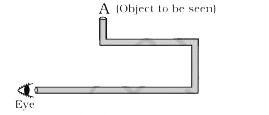Can you explain how reflection from the two mirrors enables you to see objects which are not visible directly?
Step-by-Step Solution:
1. Understanding the Problem: The question asks how two mirrors can help us see an object that is not directly visible. This situation often arises when there are obstacles, like walls, blocking our line of sight.
2. Introduction to the Periscope: A periscope is a device that allows us to see objects that are out of our direct line of sight. It typically consists of two mirrors positioned at specific angles.
3. Setting Up the Periscope: In a periscope, two plane mirrors are placed parallel to each other at 45-degree angles. One mirror is positioned at the top and the other at the bottom.
4. Light Reflection Process:
- When light rays from an object hit the top mirror, they reflect downwards at a 45-degree angle.
- The light then travels to the bottom mirror, where it reflects again at a 45-degree angle.
- Finally, the light rays head towards our eyes, allowing us to see the image of the object.
5. Conclusion: Through the use of two mirrors in a periscope, we can see objects that are not directly in front of us by utilizing the principles of reflection. This method is especially useful in situations where direct visibility is obstructed, such as in submarines or around corners.
- When light rays from an object hit the top mirror, they reflect downwards at a 45-degree angle.
- The light then travels to the bottom mirror, where it reflects again at a 45-degree angle.
- Finally, the light rays head towards our eyes, allowing us to see the image of the object.
Topper's Solved these Questions
- BOOK - PEARSON IIT JEE FOUNDATIONCHAPTER - LIGHTEXERCISE - CLASSROOM CORNER (C. Long Answer Type Questions )15videos
LIGHT
- BOOK - PEARSON IIT JEE FOUNDATIONCHAPTER - LIGHTEXERCISE - COMPETITION CORNER59videos
LIGHT
- BOOK - PEARSON IIT JEE FOUNDATIONCHAPTER - LIGHTEXERCISE - CLASSROOM CORNER (A. Very Short Answer Type Questions) ( Assertion - Reason Type - Questions)4videos
LIGHT
- BOOK - PEARSON IIT JEE FOUNDATIONCHAPTER - KINEMATICS EXERCISE - CONCEPT APPLICATION (Level 3) (Application Based Questions )5videos
KINEMATICS
- BOOK - PEARSON IIT JEE FOUNDATIONCHAPTER - MAGNETISM EXERCISE - CONCEPT APPLICATION (Level 3)4videos
MAGNETISM
Similar Questions
How can you see an object in the dark?
View SolutionWhich cells of the retina enable us to see coloured objects around us?
View SolutionWhich cell of retina enable us to see coloured objects around us ?
View SolutionHow many images are formed when two plane mirrors are placed parallel to each other?
View SolutionBoojho planned an activity to observe an object A through pipes as shown in Fig. 16.8, so that he could see objects which he could not directly see.

How many mirrors should he use to see the objects?View SolutionHow can you explain the existence of analogous organs ?
View SolutionCan you change linear magnification of a spherical mirror by changing the object distance from the mirror?
View SolutionHow are cancave and convex mirrors constructed ?
View SolutionWrite the word LEFT as you would see it in a plane mirror.
View SolutionYou have learnt in the text how Huygens' principle leads to the laws of reflection and refraction. Use the same principle to deduce directly that a point object placed in front of a plane mirror produces a virtual image whose distance from the mirror is equal to the object distance from the mirror.
View Solution

